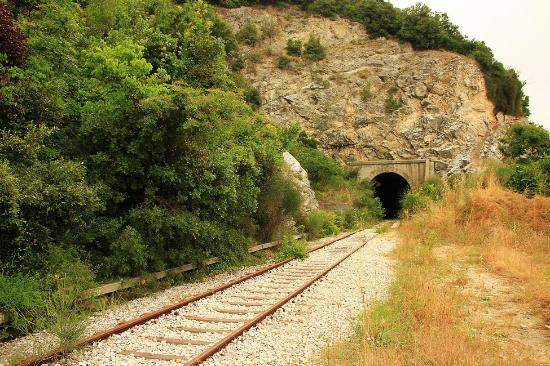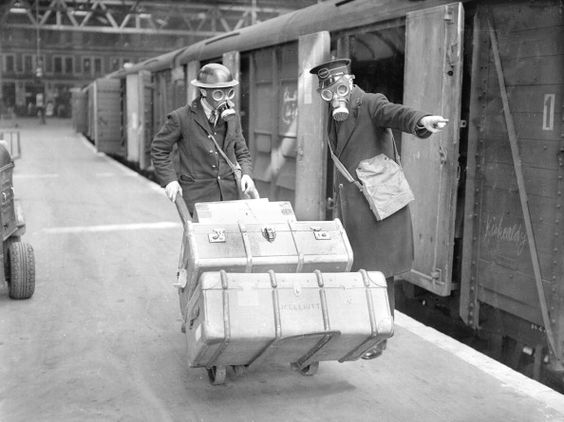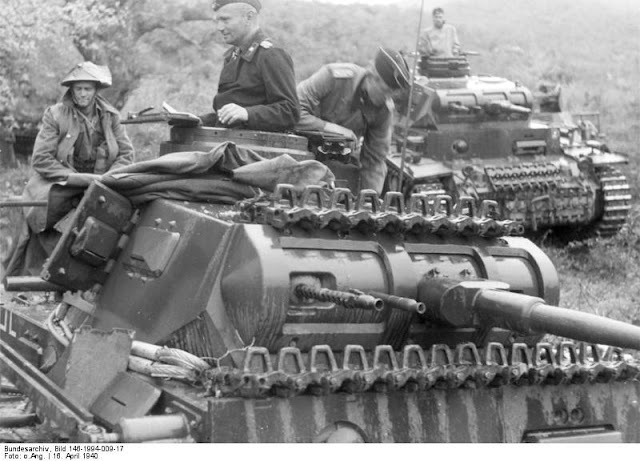Friday 18 April 1941
 |
| The approach to Farsala (Pharsala) bridge, Greece from the north. The Luftwaffe has just bombed a truck loaded with ammonal (Australian War Memorial). |
Local British commander General Henry Maitland Wilson informs Greek Commander in Chief Alexander Papagos that his forces will fight until the first week in May on a new line, but to do so requires the Greek Epirus Army in Albania to withdraw in good order to cover their flank. That, as everyone knows, is becoming increasingly problematic due to the swift German advance and the Greeks' very slow start and inability to hold the main roads. The main factor in the Allies' favor at this point is the rough terrain - while it is preventing the Epirus Army from moving south fast enough to help form a new line, it also is providing excellent defensive positions for the Commonwealth troops.
In the field, Germany's Operation Marita, the invasion of Greece, is proceeding at a brisk pace. The British are trying to make a fighting withdrawal to a line between Thermopylae and Corinth, but the Wehrmacht's panzers are hot on their heels. A key action takes place at the Battle of Tempe Gorge.
As a preliminary to the Battle of Tempe Gorge, the German 6th Mountain Division (General Ferdinand Schörner) has advanced to the Pinios River. Facing them on the other side is the New Zealand 21st Battalion, which has been conducting a series of delaying actions against the advancing Germans. Recently, the ANZAC troops successfully delayed advancing motorcycle troops and panzers at the Battle of Platamon, at which both sides took a fair number of casualties, and this is their next switch position. The ultimate goal is Larissa, a communications hub that essentially controls Greek north/south traffic.
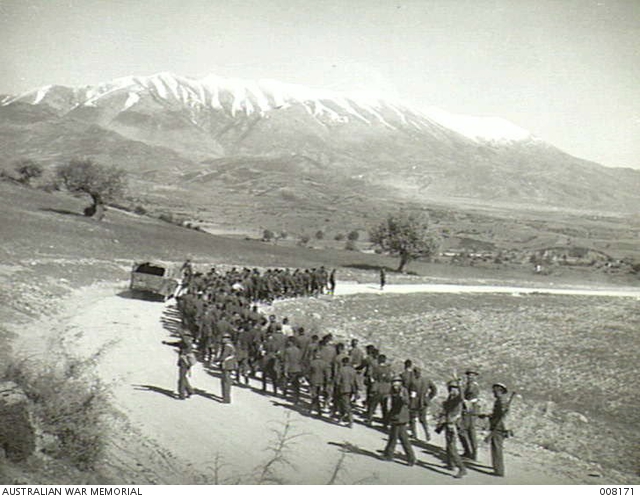 |
| Australian troops on the march in Greece, circa April 1941 (Australian War Memorial). |
After some panzers and/or Stug assault guns of the 3rd Regiment, 2nd Panzer Division find a way across the Pinios River on a pontoon bridge against fierce opposition, the New Zealanders have to give up that crossing by 17:30 and retreat into the hills. This leaves a gap in the Allied defenses. With only the Australian 2/2nd left defending the river, the battle turns into a route. At 18:45, the remaining Allied troops are ordered to retreat with all due haste. They suffer terribly in this retrograde movement, and their ordeal is not yet over - they have to stage a fighting withdrawal throughout the night to find the protection of other Allied troops.
By dawn, the surviving Australians and New Zealanders are able to join the Allied convoys streaming south on the main road to Thermopylae, having suffered 80 casualties and an additional 120 captured. The Germans, who take about 140 casualties, occupy Larissa, which closes the escape route for any remaining Allied troops further north. The Australian 2/2nd Battalion's troops are apportioned to other units for the remainder of the campaign due to their heavy losses. While the ANZAC troops are not able to delay the Germans for more than a day, that time enables many other Allied troops to retreat through Larissa to the new British line.
The Luftwaffe strafes the Allied convoys heading south, but the British retreat in good order. One problem for the Allies is that the German forces are accumulating more power steadily, while the British no longer are reinforcing their troops and instead are making plans to evacuate them (British Rear Admiral Harold T. Baillie-Grohman arrives today to coordinate that effort). Thus any defensive lines will be temporary at best.
The Italians continue tentatively occupying towns that the Greek Epirus Army is evacuating in Albania. Today, they occupy Argyrokastro.
The Luftwaffe bombs and sinks 7138-ton British freighter British Science north of the Kythera Channel. Everyone survives.
The Luftwaffe bombs and sinks 1158-ton Greek freighter Fokion and 968 ton Greek freighter Leon off Euboea Island.
The Luftwaffe bombs and sinks 1121-ton Greek freighter Chios off Chalkis, near Eretria. Near the same spot, the Luftwaffe badly damages 5199-ton Greek freighter Moscha L. Goulandri. The captain beaches her at Chalkis, where she makes a tempting target for further attacks.
Iraq War: The Indian 20th Infantry Brigade, sent from Karachi by GHQ India, lands at Basra, Iraq. The 20th Infantry Brigade quickly seizes the key port of Basra. It is the first new element to arrive of Iraqforce, at this time called Sabine Force, under the command of Major-General W.A.K. Fraser.
The British government does not recognize the new pro-Axis Iraq government of Rashid Ali and wishes to install a friendly government in Baghdad. Meanwhile, upstream, the Iraqis have begun moving troops and artillery toward the British airfield at Habbaniyah, but have not attacked at this time. Ali already has requested aid from Germany, but that technically is a very difficult thing to accomplish at such a distance with the Royal Navy in complete command of the seas. Luftwaffe support is possible, but the British control the airfields and much of the intervening airspace.
The Luftwaffe forms a new night-fighter unit, NJG 4 (Major Rudolf Stoltenhoff is Kommodore). The unit is based at Metz and at first, is composed of Bf 110s and Do 217s.
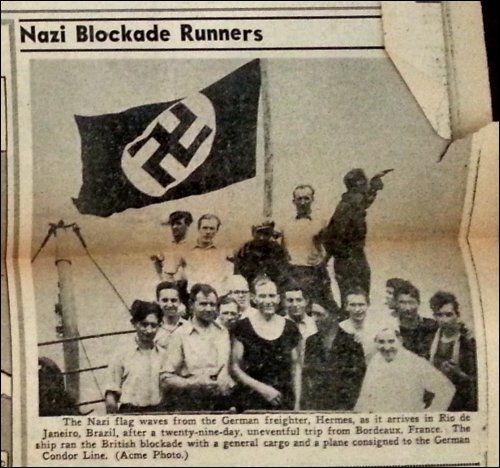 |
| An article about German blockade runners publicizes the recent arrival of German freighter Hermes in Rio de Janeiro, Brazil from Bordeaux, France (St. Louis Star-Times, April 18, 1941). |
Royal Navy submarine HMS Urge torpedoes and sinks 10,535-ton Italian tanker Franco Martelli in the Atlantic about 300 miles (500 km) west of St. Nazaire. The Franco Martelli was trying to pierce the Royal Navy blockade en route from Brazil.
The Luftwaffe bombs and damages 6998-ton British tanker Scottish Musician just off St. Ann's Head. The Scottish Musician is towed to Newport. There are two deaths.
The Luftwaffe bombs and damages 3938-ton Panamanian freighter Csikos off the Scottish coast. The ship manages to make it to Lough Foyle. There are two deaths.
The RAF torpedoes and sinks 289-ton German torpedo boat V-709 Guido Möhring in the Bay of Biscay off Port Ley. By some accounts, this is just a local fishing boat.
Two Royal Navy destroyers, HMS Newark and Volunteer, collide north of Rathlin Island and are seriously damaged. They are both towed to Belfast and take four months to repair. There are five deaths.
Destroyers HMS Whitshed and La Melpomene (French) are in a collision off of Harwich. The La Melpomene is under repair for just over a month.
Royal Navy 88 ton drifter Young Ernie collides with another ship in the Tyne and sinks.
French cargo ship Champenois, carrying a load of Barley, runs aground about 37 km north of Casablanca, Morocco. The ship is written off. Some accounts place this incident on the 19th.
Royal Navy minelayer HMS Teviotbank lays minefield BS 54 off the east coast of England.
Convoy OB 312 departs from Liverpool.
 |
| Indian troops of the 4th Infantry Division man a Bren machine gun on an anti-aircraft mounting, the Western Desert near Sidi Barrani, 18 April 1941. |
It was an act of improvidence to send the whole Division all his way back, in view of the fact that German elements were already reported in Tripoli. The whole of the Tanks in this division could not have been all in simultaneously in a condition of needing prolonged heavy repairs. Workshops should have been improvised at the front for lighter repairs, and servicing personnel sent forward.... General Wavell and his officers seem, however, to have thought that no trouble could arise before the end of May. This was a very serious miscalculation, from which vexatious consequences have flowed.Generals Dill and Wavell, of course, know all about "workshops" and the like and do not need to be lectured to about the same. Wavell is privy to the Ultra intercepts which did support a rational conclusion that the Germans would have to wait until May to launch an offensive. In fact, only Lieutenant General Erwin Rommel's initiative and dash contrary to orders resulted in the German offensive beginning early. Rommel confounded everyone - on both sides.
Churchill is not alone in his disparagement of the Middle East Command - his influence is affecting those around him, too. Visiting Australian Prime Minister Robert Menzies, who met with Wavell only a couple of months ago and at that time found him capable, now notes in his diary that:
I must insist upon Australians getting proper commands, for I have more confidence in them than I do in Wavell & Co., whose gross miscalculations have brought us to this pass.This incident indicates why many military men who deal with Churchill directly, such as Dill, take a much dimmer view of Churchill than does the public at large.
On the ground in North Africa, little changes during the day. General Rommel moves his headquarters three miles from the Green Mountain, about 30 km west of Tobruk. This is further from the port than where it had been previously and suggests that he is preparing for a lengthy siege. He awaits more units of the 15th Panzer Division before launching another attack - something that the German High Command wanted him to do before starting his most recent (and very successful) offensive.
Australian General Leslie Morshead, in charge at Tobruk, reorganizes his defenses. He has his men build a secondary defensive line behind the one built by the Italians and creates additional reserve forces in case of a breakthrough.
At sea, the Royal Navy's Mediterranean Fleet puts out to sea for a major operation aimed at bombarding the German positions in Libya. The two related operations are MD 2 and MD 3. This will play out over the next few days.
The Luftwaffe begins receiving some reinforcements as I,/JG 27 begins arriving at Ain-el-Gazala.
The Luftwaffe bombs and sinks 2190-ton Royal Navy convoy service ship HMS Fiona about 50 miles (80 km) off Sidi Barrani. There are 53 deaths flowing from the attack.
Two separate Italian convoys, one of four ships with five escorts and the other of four ships, depart from Palermo bound for Tripoli. The first convoy sails at 08:00, the other at 23:00.
 |
| "Australian Army Ford 4x4 artillery tractor towing a No 27 Mk I limber and an 18 pounder Mk IV field gun in the Verroia Pass, Greece, April 1941" (Australian War Memorial). |
Battle of the Indian Ocean: British steel flat Punduah sinks in rough seas while under tow in the Bay of Bengal.
Convoy BM 7 departs from Karachi with ten troop transports. It carries an Indian brigade and an artillery group bound for Malaya, with the first stop at Shatt el Arab.
POWs: About 80 Axis prisoners stage an escape attempt at the Angler POW Camp in Neys Provincial Park, Ontario, Canada. Everyone is recaptured, the last two at Medicine Hat, Alberta. This is known as the Angler Escape.
Anglo/Soviet Relations: Winston Churchill memos Foreign Secretary Anthony Eden, asking, "Has Sir Stafford Cripps yet delivered my personal message of warning about the German danger to Stalin?"
Anglo/German Relations: Churchill and the War Cabinet order publication of a statement to the effect that if the Germans bomb Athens and Cairo, the RAF will bomb Rome. RAF Chief Air Marshal Sir Charles Portal objects that bombing Rome is not really within the RAF's capabilities without extraordinary effort, to which Churchill replies that they will assess the situation at the time should the need to bomb Rome arise. This is basically how the two sides communicate throughout much of the war - through press releases.
Pan-American Relations: The United States defines a Pan-American Security Zone based upon the 3 October 1939 Declaration of Panama. It extends to 26 degrees west longitude, which is about 2300 nautical miles west of New York City. It comes to within 50 miles of Iceland, where Royal Navy escorts can take over.
 |
| Looking little like its final form, Me 262 V1 with a Jumo 210G piston engine in the nose takes off on its first flight today, April 18, 1941. |
The Me 262 has been under development since shortly before the beginning of the war as Projekt 1065 (P.1065). It is not the only German jet fighter under development in Germany, either. In fact, the competing Heinkel He 280 already has flown on jet power. However, the Reichsluftfahrtministerium (RLM, Ministry of Aviation) is placing its bets on the Me 262, perhaps because it has more confidence in the BMW 003 engine than in the independently produced Heinkel engine. In any event, the RLM is not too concerned about jet aircraft at this time - Hermann Göring, head of the Luftwaffe, cut the engine development program to just 35 engineers in February 1940. Everything depends upon the engine, so critical decisions are being made at this stage of the war that will greatly impact the development of the Me 262 later when it is really needed.
Japanese Military: The Japanese Imperial Air Force sends a Mitsubishi G3M2 "Nell" bomber based in Formosa (Taiwan) flies over Luzon for some photo-reconnaissance.
 |
| Australian transport officers handling their transport vehicles in Greece. One officer appears to be wearing an Australian hunting hat (Australian War Memorial). |
The ground also is broken for the Willow Run Bomber Plant in Detroit, Michigan. The Willow Run plant, run by Ford Motor Company, will produce B-24 components that will be assembled by Consolidated at the Fort Worth plant (and also at the Douglas Aircraft plant at Tulsa, Oklahoma). Willow Run is to be built by Ford, sell it to the government, run operations there under a lease for the duration of the war, and then have an operation to purchase the plant after war production ends.
Vichy France: The French abandon the League of Nations, which is inert anyway.
China: The Japanese launch another in a series of air raids against Chungking.
American Homefront: An internal debate is raging at General Motors about how far it must go to support the Roosevelt administration in its anti-German posture. A main issue on the table is administration pressure for GM to sever its association with South American car dealers suspected of having pro-German sympathies. Another issue is the administration's demand that US auto manufacturers drastically curtail their production to aid the war effort - when the US is not at war. The company is resisting both of these administration initiatives.
Today, Walter Carpenter, a GM board member, writes to GM President Alfred P. Sloane:
The country today seems to be pretty well committed to a policy opposite to Germany and Italy. If we don’t listen to the urgings of the State Department in this connection, it seems to me just a question of time... The effect of this will be to associate the General Motors with German or Fascist propaganda against the interests of the United States.Around this time, the US FBI is investigating GM senior executives for disloyalty to America. What they find is an absence of disloyalty, but some collusion with Germany by GM's head of overseas operations James D. Mooney. This issue will continue to haunt GM for decades.
 |
| A panel from a comic strip that appears in US papers today, 18 April 1941. |
April 1941
April 1, 1941: Rommel Takes Brega
April 2, 1941:Rommel Takes Agedabia
April 3, 1941: Convoy SC-26 Destruction
April 4, 1941: Rommel Takes Benghazi
April 5, 1941: Rommel Rolling
April 6, 1941: Operation Marita
April 7, 1941: Rommel Takes Derna
April 8, 1941: Yugoslavia Crumbling
April 9, 1941: Thessaloniki Falls
April 10, 1941: USS Niblack Attacks
April 11, 1941: Good Friday Raid
April 12, 1941: Belgrade and Bardia Fall
April 13, 1941: Soviet-Japanese Pact
April 14, 1941: King Peter Leaves
April 15, 1941: Flying Tigers
April 16, 1941: Battle of Platamon
April 17, 1941: Yugoslavia Gone
April 18, 1941: Me 262 First Flight
April 19, 1941: London Smashed
April 20, 1941: Hitler's Best Birthday
April 21, 1941: Greek Army Surrenders
April 22, 1941: Pancevo Massacre
April 23, 1941: CAM Ships
April 24, 1941: Battle of Thermopylae
April 25, 1941: Operation Demon
April 26, 1941: Operation Hannibal
April 27, 1941: Athens Falls
April 28, 1941: Hitler Firm about Barbarossa
April 29, 1941: Mainland Greece Falls
April 30, 1941: Rommel Attacks
2020



